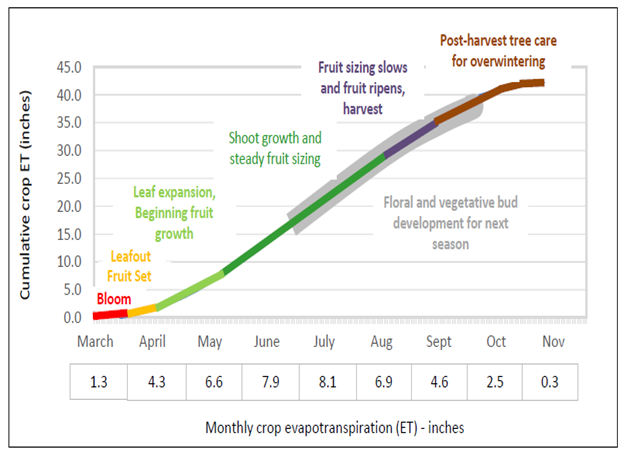Allan Fulton, UCCE Water Resources Advisor, Tehama, Glenn, and Colusa Counties; Luke Milliron, UCCE Farm Advisor, Butte, Glenn and Tehama Counties & Franz Niederholzer, UCCE Farm Advisor, Colusa and Sutter/Yuba Counties
Tree and crop development progresses through multiple phases during the season (Figure 1). They include expansive tree growth and fruit development, floral and vegetative bud development [for next year] as well as fruit ripening that leads up to harvest and the post-harvest period. Average monthly ET and the gradual seasonal ET accumulation are also given in the figure.

Tree canopies are developed in mature orchards and new shoot growth should be apparent in the tops of the trees. Green fruit are now beginning to size. Irrigation needs will steadily increase during the remainder of May and June and will reach a plateau in July. Fruit growth (sizing) can be affected by irrigation in the next two to three months. Fruit sizing studies have shown that irrespective of the level of fruit thinning and fruit load, there is a very steep rate of fruit sizing from mid-June til late July. While fruit growth slows in August, fruit subsequently “sugars up” and adequate orchard water status is needed to drive photosynthesis and produce sugar for the fruit. It is important to supply prune orchards with adequate irrigation to continue to support expansive fruit sizing and sugar content during the next 75 to 90 days. As harvest nears, it may be beneficial to cut off, or significantly reduce irrigation in the 1-3 weeks ahead of shaking in order to increase sugar concentration, reduce trunk damage and keep dry-away as low as possible. The timing for best preharvest irrigation cutoff differs from orchard to orchard, so growers should follow experience to decide the best irrigation cutoff timing for each block as harvest approaches.
As August approaches, keep an eye out for the initial color change in the fruit skin, a hint of purple along the suture line, indicates fruit maturity is about 30 days off. Use this information to help implement irrigation cutbacks ahead of harvest.
Not all crop ET needs must necessarily be supplied by irrigation. In-season rainfall, soil water storage from winter rains, and in some orchard settings, capillary rise of moisture from a shallow water table may help supply the needs. Monitoring orchard water status with a pressure chamber is one option that can help make irrigation decisions and help ensure the crop is efficiently and sufficiently irrigated. Guidelines are provided below (Table 1) to help interpret pressure chamber measurements.
Table 1. Stem water potential (SWP) levels in prune and how SWP might compare to the fully watered baseline values under various weather conditions, as well as the corresponding water stress symptoms to expect.
| SWP Range (bars) | General Stress Level | Baseline Consideration | Water Stress Symptoms in Prune |
| -2 to -6 | None | (Likely above typical baseline) | (Not commonly observed) |
| -6 to -8 | Minimal | At or near baseline under normal or cool weather conditions | Typical in March and April. Indicates soil moisture is not limiting. If sustained higher incidence of root and foliar diseases and tree loss may occur. |
| -8 to -12 | Minimal to Mild | At or near baseline under hot, dry conditions, but may be 2 to 4 bars below baseline under normal or cool conditions | Favors rapid shoot growth and fruit sizing in orchards when minimal crop stress is sustained from April through mid-June. |
| -12 to -16 | Mild to Moderate | May be 2 to 4 bars below baseline under hot, dry conditions, but may be 4 to 6 bars below baseline under normal or cooler weather | Suggested mild levels of stress during late June, July, and early August. Shoot growth slowed but fruit sizing unaffected.May help manage energy and irrigation cost |
| -16 to -20 | Moderate to High | Within 6 to 8 bars below baseline | Should be avoided until fruit sizing is completed. Appropriate for late August after fruit sizing is completed. Imposing moderate to high levels of crop stress by reducing irrigation about two weeks before harvest may increase sugar content in fruit and reduce moisture content or “dry-away” (fruit drying costs). |
| -20 to -30 | High to Severe | Within 8to 20 brs below baseline | More likely to occur in late August and early September during and after harvest. Extended periods of high crop stress before harvest will result in defoliation and exposure of limbs and fruit to sunburn. Extended periods of high stress after harvest may also negatively affect the condition of trees going into dormancy. |
| Below -30 | Extreme | (Substantially below baseline under all conditions) | Extended periods of severe crop stress should be avoided. Trees will defoliate and be exposed to sunburn, increasing the risk of canker diseases. Potentially shorten productive life of orchard. |


Leave a Reply